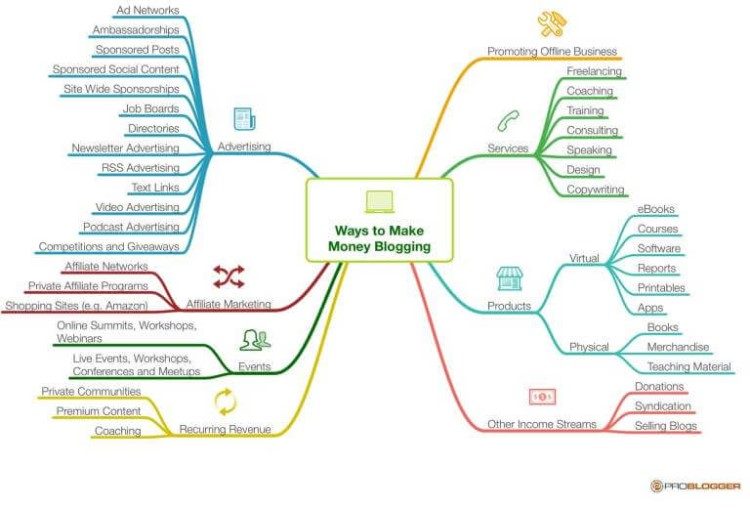This income range is too broad to get any real insights, but I’m not going to leave you hanging. Let’s break it down and see how much bloggers are actually making and how they’re doing it.
Is Blogging Dead in 2023?
Is it too late to start a blog in 2023? This same question has been popping up every year for the last 10+ years. Short answer: No, blogging is not dead. Longer answer: Blogging is more competitive than ever before, but it’s an absolutely thriving industry.
92% of content marketers include blog posts as part of their strategy 89% of content marketers state they use organic search for content distribution 60% of people find blog posts valuable in the early stages of buying something WordPress users create around 70 million new blog posts per month WordPress blog posts get more than 409 million views per month
We now have Facebook, YouTube, Instagram, Twitter, Tiktok, and so many other platforms that capture user engagement. Blogging is no longer about telling stories about your life. To succeed today, treat your blog like a business.
Can You Make Money Blogging?
This question, or some variation of it, is always on people’s minds. So much so that this exact question still got 1,600 hits on Google per month in 2021. Can you make money blogging? How much money can you make blogging? Do bloggers actually make money? The answer to all these questions is the same. Yes, you can earn money from blogging! However, there is some nuance to that. Not everyone WILL make money from blogging. If you want to make money with a blog, you have to take the right approach.
How Much Do Bloggers Make a Month or a Year?
The problem with this question is that there’s a huge disparity between what many bloggers make. Some make $0, some $1000 per month, and some $100,000 per month. Even though there’s no way to easily answer how much bloggers make, I’m going to give you as much information as I can to help you get a feel for the potential.
How Much Does the Average Blogger Make?
Have you ever heard of the Pareto Principle? Economist Vilfredo Pareto stated that 80% of the output goes to only 20% of those making inputs. This principle applies far and wide. In blogging, it’s a little more unbalanced, with probably 90%-95% of the output going to 5%-10% of bloggers. The average blogger might make somewhere between $0 – $1,000 per month, but do you really want to be in that category? Aim higher. The average blogger in the 5%-10% is earning closer to $5,000-$10,000 per month.
Glassdoor
For the job title “Blogger”, this is what Glassdoor says about average earnings: While the average is listed as around $50,000 per year, the majority of people make much less than that, sitting closer to $28,000 – $30,000 per year. This is for career bloggers who work for other companies. The next stats are from bloggers who run their own blogs.
ProBlogger
These were the responses from a ProBlogger survey on blog owners’ monthly earnings, showing the percentage of people in specific income brackets:
$0 – 10% Under $10 – 28% $10 – $99 – 25% $100 – $499 – 17% $500 – $999 – 7% $1000 – $9999 – 9% Over $10,000 – 4%
Digital Nomad Wannabe
According to Digital Nomad Wannabe’s survey of their blog owner audience, this is what their bloggers earn in profits on a monthly basis, by percentages:
$0 – 27% $1 – $200 – 23.1% $201 – $500 – 10.6% $501 – $1000 – less than 10% $1001 – $2500 – 12.8% $2500 – $5000 – less than 10% $5001 – $10,000 – less than 9% $10,000 – $19,999 – less than 3% $20,000+ – 1.9%
My Work from Home Money
Lastly, a survey from My Work from Home Money showed these figures for blogger income, by percentages:
Under $10 – 17.6% $10 – $100 – 6.5% $100 – $500 – 14.8% $500 – $1500 – 11.1% $1500 – $3500 – 13.9% $3000 – $5000 – 13% $5000 – $10,000 – 14.8% $10,000+ – 8.3%
Some of these numbers are small sample sizes, but the general trends match across platforms. The reason there’s variation between the answers comes down to the audience that was polled. The averages shown by these surveys and collections of salary data may not accurately reflect the general public, but it’s still effective at giving you a feel for how much people can earn from blogging.
How Much Do the Most Successful Bloggers Make Per Month?
As you can probably see, there’s a huge gap between what the average blogger makes and what the most successful bloggers make. The top 5 – 10% of bloggers make way more than the bottom 90 – 95% combined. From the same surveys above:
ProBlogger: 4% make above $10,000 per month Digital Nomad Wannabe: 1.9% make above $20,000 per month My Work from Home Money: 8.3% make above $10,000 per month
That’s not the full story. Just how much more than $10,000 or $20,000 are they making? To give you an idea about the upper limits on your earnings, here is what a few of the highest-earning blogs brought in during 2020:
HuffPost – $500 million Engadget – $47.5 million Moz – $44.9 million PerezHilton – $41.3 million Copyblogger – $33.1 million Mashable – $30 million TechCrunch – $22.5 million Envato Tuts+ – $10 million Smashing Magazine – $5.2 million Gizmodo – $4.8 million
I can hear it now: “But, these are all businesses, not blogs!” That’s the point. None of these blogs started out as large businesses. They were ALL blogs first and businesses later. Let’s look a little closer at some of the founders of these top blogs.
Story of Successful Bloggers: Moz Founders Rand Fishkin & Gillian Muessig
Moz is one of the best-known SEO resources online today. It’s a gold mine for everything SEO, but it started from humble beginnings. Here’s the story: Moz was founded by Rand Fishkin and his mother Gillian Muessig in 2004. They had been working together already making websites and doing digital marketing for business, with little to no success, and ended up with almost $500,000 in personal debt. This was a turning point for them, as Rand started having to do more of the legwork with SEO instead of contracting that service out. Since there were very few places to learn about SEO at that time, Rand and Gillian launched the free blog SEOmoz.com to act as a place for people to talk about SEO and learn together. That’s all it was for a few years, just a place to share information about SEO. As more and more people started to use the website, the costs of maintaining it as a free website increased, so the pair decided to launch a membership plan for access to the tools they used for their own SEO. So many people subscribed that the monthly revenues from their tools matched what they were making from SEO consultations. By 2007, Moz was taking on seed investment to develop SEO tools. By 2017, they were drawing in over $40 million in revenues annually. If they hadn’t started their blog, would Moz have been as successful as it is today? The blog acted as a platform to build industry authority and create a dedicated following of people who were willing to purchase products and services from Moz. What started as a way to learn turned into a fantastic launching pad for SEO tools and analytics software. Moz may be aspirational, but what about more realistic examples? It’s not just million-dollar blogs that deserve a spotlight. Others have found great success and freedom through their blogs without ending up on the top 10 earners list. Here are their stories.
Michelle Schroeder – Making Sense of Cents
Making Sense of Cents is a personal finance blog founded by Michelle Schroder in 2011. At that time, she was a college student accruing a ton of student loan debt. By the time she graduated with an MBA in 2012, she had around $38,000 in student loan debt. That was even with working full-time throughout her studies.
She switched to blogging full-time in 2013 at just 24 years old. At that point, she said her side hustle was making just as much as her full-time job. After the switch, she still managed to pay off her entire student loan debt later in the year through money earned from blogging. In 2018, Michelle made over $1,500,000 from her blog. That is the most recent year she published her income. Here is what she made historically since she switched to full-time blogging:
$1,536,732 in 2017 $979,321 in 2016 $320,888 in 2015 $163,929 in 2014 $116,519 in 2013
Although there are no exact figures, the breakdown of where her income came from in 2019 looks like this:
62% from affiliate marketing 20% from online courses 16% from sponsored partnerships 2% from display ads
Chelsea Brennan – Smart Money Mamas
Smart Money Mamas is a blog targeting mothers who want to make their money work for them through investing. It was founded by Chelsea Brennan in 2017 as a passion project. Chelsea worked for a hedge fund investment company when she first started blogging. Although she was making a steady income, her job wasn’t having any real social impact, something that was very important to her. To start the blog, Chelsea asked moms on a Facebook group she was in to share their money questions. After getting around 60 responses, she started to work on answering those questions in the form of blog posts on her freshly launched blog.
Within about 2 years of starting the website, engaging with her audience, and really connecting with her mission, Chelsea made the decision to resign from her job and focus full-time on her blog. Based on their existing savings and a budget she worked up, she gave herself 2 years to give it a try. In Q1 of 2018, Chelsea’s blog made $4,127 in revenues and $2,772 in net income. This was from affiliate marketing, Google Ads, and additional freelance writing for other blogs. In Q2 of 2018, she managed to increase her revenues to $6,308 and net income to $4,052. Since then, she hasn’t posted any other income reports, but her blog has grown significantly and now includes a podcast, online tools, and a financial products shop.
Darren Rowse – ProBlogger
ProBlogger was founded in 2004 by Darren Rowse. He started his own personal blog in 2002, less than 24 after reading an article about how to start blogging. Although his first blogs were passion projects about pop culture, spirituality, and blogging itself, he decided to start trying to monetize his blogs as they got more popular.
Enter ProBlogger. At this point, Rowse was already making some money on his other blogs. This was initially a website geared towards tracking the progress of growing and monetizing those blogs, but it transformed into a powerhouse as his audience kept on growing. As it turns out, a lot of people wanted to learn about how to make money on their blogs! ProBlogger does not post any specific figures, but in 2016 Rowse published a breakdown of where the money comes from. Rowse’s income from ProBlogger comes from a few different sources, namely:
Affiliate marketing (46%) Product sales (books, courses, printables, photography presets) (31%) Adsense (8%) Sponsorships (6%) Job Board (5%) Events (3%) Speaking engagements & royalties (1%)
These are the numbers for both ProBlogger and Rowse’s other large blog Digital Photography School.
James M Dahle, MD – The White Coat Investor
In 2011, James Dahle started The White Coat Investor, a blog aimed at personal finance for physicians. As a working physician, Dahle kept getting ripped off by financial professionals and was losing money instead of growing wealth, even with his high-earning white-collar job. Dahle took time to educate himself on how to invest his money and the best high-yield strategies for high-earning professionals. That’s when The White Coat Investor was started. He decided to share what he’d learned in a finance blog that specifically targets an audience of physicians and medical professionals.
Although Dahle used to publish income reports annually, he made the decision in 2019 to stop and also removed financials from the reports in 2015 and onwards. So, while we can’t look at what he earned in the most recent years, we can still look at what a few years of his earnings:
In 2014, the White Coat Investor brought in $187,862 In 2013, they brought in $28,379 In 2012, they made $8,939
Based on the most recent reports, White Coat Investor makes money through these channels:
Book sales & royalties Privately placed advertisements Writing & speaking requests Affiliate agreements Adsense & other ad placement services Online courses Conferences & Events Network participation
Grant Sabatier – Millennial Money
Millennial Money is a blog that was started by Grant Sabatier in 2015. It’s a personal finance blog that aims to help millennials earn, invest, and save money to the best of their abilities. The goal is to make financial freedom more accessible.
Grant achieved financial freedom by the age of 30. This means work became optional, so he could focus more on what he wanted to do than on what he had to do to survive. He went from having no assets and only $2.26 in the bank to be a millionaire within 5 years. That success is largely thanks to his blog and the opportunities that came from it. The latest income report from Millennial Money was in 2017. Their earnings that year were $401,681. Here’s the breakdown of where it came from:
Direct advertisers & sponsored content – $17,800 Brand partnerships and consulting – $92,900 Affiliates and display advertising – $127,400 Other income (books, speaking engagements, coaching, courses, freelance writing) – $163,581
What All Successful Bloggers Have in Common
All the blogs we just talked about and others that generate an income have a few things in common. They may be in different niches and they may even monetize in different ways, but these things remain constant for all of them:
Blog Traffic
The basic thing that every income-generating blog has is site traffic. Without traffic, you simply can’t get paid. The more traffic you have, the higher your earning potential. You get more ad views and interactions. More people use your affiliate links. Sponsors are willing to pay more for a post on your blog. There’s a larger pool of customers for any products or services you offer. Most full-time bloggers with money-making blogs have at least 100,000 page views per month. Overall, blog traffic is the #1 driving factor for generating income. You can make money with a low-traffic blog, but it’s easier to make money the more traffic you have. This is mainly talking about organic traffic from search engines and direct links. Traffic may also come from ads and other sponsored inbound marketing efforts, but the most sustainable way to keep your blog strong is to build up your organic traffic.
Email Lists
A 2019 study found that for every £1 you spend on email marketing, you’re likely to get back an average of £42! That’s some of the best ROI you can get with content marketing. I dare you to try to find a successful blog that doesn’t have an email list. A solid email list and a good email marketing strategy go a long way in your quest for an income-generating blog.
Dedicated Followers
The best blogs have a collection of people who follow their content regularly. Blog followers are people who trust you and the brand you’ve built, making them more likely to purchase your products or services, recommend your blog to others, and continuously engage with your website. People that follow blogs and read regularly do so because those blogs provide them with value. That means in exchange for interacting with your blog, they leave with something valuable, be it entertainment, knowledge, a new perspective, a product, or anything else. How do you know how to provide value?
Deep Audience Understanding
Providing value is only possible if you know your audience. How can you give someone valuable knowledge, tools, resources, and recommendations if you have no idea who they are or what they need? You can’t. Successful bloggers tend to have a thorough understanding of their audience, either because they are/were in the same stage of life as their audience or because they take the time to reach out and listen.
How Do Bloggers Make Money?
There are countless ways that a blog can make money for you. It’s not a static thing. This graphic from ProBlogger might give you a little glimpse into just how many options you have:
Let’s take a quick look at some of the most common monetization strategies.
Digital Ads: Ezoic vs Adsense vs Mediavine
Google’s Adsense has the lowest payment rates for bloggers in most industries but has no official pageview requirements to apply. Ezoic requires 10,000 page views per month to apply (or less with manual authorization if you have a great blog!), but they tend to perform better than Adsense because the ads are more targeted. Mediavine requires 25,000 sessions per month and a majority of your traffic comes from the US. They offer higher rates for ads but are not as accessible to new bloggers. Both Ezoic and Mediavine are partnered with Adsense. What they do is optimize and manage the ads you get on your page to increase the chances of getting the right ads in front of your audience. It’s difficult to make a full-time income from ads unless you have a high number of page views.
Is Adsense Worth It?
Adsense is probably worth having on your blog unless you’re monetizing through affiliate programs, sponsorships, and other direct advertising. It’s super easy to get connected to Adsense and it’s completely passive income. All you have to do is put a short line of code on your site and you can start showing ads. What you’ll earn from Adsense varies based on your industry and the specific niche you serve. Your views and whether you get served with CPC or CPM ads also matter. Adsense is also the fastest way to start making money with a blog. You can apply almost immediately for an account and start putting ads on your blog. As long as your blog has a solid amount of content on it and is a few months old, you’re likely to get approved. With Adsense, you’ll start getting paid monthly every time you reach the threshold of $100. The average amount you’ll earn per 1000 pageviews can range from $2-$5 in unprofitable niches to $5-$10 in medium profitable niches or $50+ in highly profitable niches.
How Much Money Bloggers Can Make with Affiliates?
Established bloggers often make anywhere from $500 – $5,000 per month from affiliate sales. If you already have some consistent traffic on your site, you can start earning $100 – $500 per month on affiliate sales pretty quickly. Using the best-paying affiliate links (BlueHost, HostGator, Hostinger, Cloudways, WP Engine, etc.), you can earn more like $1000 – $2500 with decent traffic, and a lot more with high traffic. Tip: If you have a few posts on your blog already, look for complementary products and services that you can recommend in line with whatever you’re talking about already.
How Much Do Bloggers Make Per Sponsored Post?
Sponsored posts are much more official than regular blog posts. Because of this, it’s recommended that you charge more for these posts than you would pay for a writer for a normal post. A good baseline minimum is $250 per sponsored post, although some brands will likely shy away from this budget if you don’t have the traffic to give them the results they would want. Some sponsored posts may start from $25+. It’s up to you to manage your value and decide what you’re willing to sell your blog space and audience attention for. The more traffic you have, the higher you should go. A helpful website for getting the hang of sponsored post pricing is Social Blue Book. Make an account there and you can start looking up estimates for sponsored posts that match what you want to do. Note that the estimates they give are usually on the low side, so don’t be afraid to increase the price if you feel it’s too low.
How Much Do Bloggers Make with Their Own Course or Product?
Bloggers with a significant existing audience and those who are in highly profitable niches tend to make more money with online courses and learning products. However, it’s still a monetization option for any blogger willing to make a solid product. Most course creators, even those on dedicated learning platforms, make $2,500 or less per month and enroll under 50 students each month. If you’re new to blogging, your numbers are likely to be a lot lower, closer to $100 per month until you can get more traffic. Course earnings depend on:
Traffic Course Price Audience Dedication Demand Course Quality
The eLearning industry was worth over $190 billion in 2018, with even more growth in 2020, so it’s safe to say there’s plenty of money to go around. Your job is figuring out how to secure a bigger piece of the pie.
What Is the Fastest Way to Make Money Blogging?
When you’re just starting a blog, no one is going to be paying you for your work. It’s all up to you to get some momentum and push things forward. How can you get money fast from blogging? The quickest way to start is by offering freelance services. Since you have a blog, you probably have at least one skill you can offer people. Do you write your own content? Sell your services as a writer. Did you make your own interesting visuals for your website? Sell your services as a graphic designer. Did you build your own website? Sell your services as a web designer or developer. Does your niche offer any sort of consulting opportunities? Take advantage of your subject matter knowledge to provide niche-specific consulting. Do your articles rank well on search engines? Offer SEO consulting services. I think you get the idea. Whatever you do, don’t get short-sighted with your monetization strategy. Just because you’re making some money with freelancing doesn’t mean you should just relax and let it happen. While you grow your traffic, actively build your other opportunities. What else can you be doing in the meantime? There’s a big difference between getting money fast from a blog and getting paid as well as possible. Focus on creating at least one income stream quickly than building up the other streams over time.
How to Make Money Blogging for Beginners?
For most new bloggers, the first milestone is reaching $1,000 per month in earnings from your blog alone. It feels aspirational at first, and nearly impossible. The good news is that it’s not impossible. You don’t have to wait 3 – 5 years to start making money with your blog. By making smart decisions and thinking about monetization strategies early, you can make money as a beginner blogger.
Step 1: STARTING
As silly as it sounds, you’re never going to make any money blogging until you actually have a blog. I’m willing to bet at least 50% of the people reading this article will click away and forget all about blogging within a few days. Don’t be part of that 50%. To start a blog, all you need is a solid niche and a few dollars for a basic hosting plan. That’s it! You can even avail of a free hosting solution that ensures your content is secure and reliable when it reaches your customers. I have a whole guide on how to start a blog that can take you through the process step by step. [LINK TO PILLAR ARTICLE] Got your blog situation sorted out? Great! Now you can move on.
Step 2: SETTING YOUR FOCUS
As a beginner, the worst thing you can do for your income potential is to be all over the place. If you want to make money quickly and grow your revenue consistently, it’s better to have a laser focus on your topic and monetization strategy. Figure out the kind of value you can offer your audience and double down on it. Focus is easiest when you have specific goals laid out and a plan to reach them. Write down 3 goals that you want to achieve for your blog over the next 12 months. Write them first in a shortlist, then again with one goal on the top of a fresh sheet of paper. Under each goal, fill up your paper with ideas on how to reach that goal. Brainstorm as much as you want and get creative with it, as long as you believe that action or approach will genuinely help you smash your goals by the end of your 12 months. Once you have your goals and action plans, get to work.
Step 3: FOLLOW THROUGH
Making a plan is only the beginning. It’s an important step, but it’s far from over. Now, you have to actually maintain your blog and implement your monetization strategy! If you’re planning to go the Adsense route, you’re going to want a heavy focus on building traffic as fast as possible. For affiliate marketing, you want to build a loyal following of people who trust your opinions. When you’re selling freelance services, you want a good portfolio and a blog that showcases your skill. Planning on selling a course or book right off the bat? This can work if you’re already established in your industry offline (or online but new to blogging). Make sure you have a complete website with links to your social pages and something to back up your credentials. A fantastic landing page for your product is a must. You’ve already got your plan, so just do it. And then do it again. And again… …Until you finally start making money. (Then keep it up so you’ll keep making money!) Note: It may take 3 – 6 months to start seeing organic traffic from Google and other search engines. Be patient and keep working towards your goal, even if it seems far off in the beginning!
How Risky Is Blogging? Do I Have Any Chance of Success?
The simple answer is yes, you do have a chance of success if you put in the effort. To get your desired outputs, you need the right inputs. As a beginner, your input will either be time or money. Time is the most likely option if you’re just starting out. All the time in the world won’t equal success unless you’re spending that time doing the right things. In 2020, Orbit Media posted its 7th Annual Blogging Survey. Here are some of the highlights from that survey:
8.4% of bloggers didn’t know if their blog provided value 12.7% of bloggers said their blog delivered disappointing results 54.2% said their blogs delivered some results Only 24.7% of bloggers reported their blogs delivering strong results
There are many reasons for this, but a lot of it comes down to how much work the blog owner was willing to put into their blog and how they adjusted to trends in content consumption. The same survey reported that the best-performing blogs had similar characteristics:
Many long-form blog posts Blog posts that took on average 3hr 55min to write New content is posted at LEAST once per week Dynamic content with visual elements (especially videos & quotes)) Valuable, highly informative how-to articles Many draft headlines (7+)
If you want to succeed, you have to put in the time to do the right mix of things. Even then, it’s not all rainbows and sunshine. There are a lot of downsides to blogging as a moneymaker:
Blogging can suck up a lot of time without giving you anything in return Many blog niches are highly competitive You could lose huge amounts of organic traffic from unfavorable Google updates Bloggers need consistent access to a computer and a stable internet connection If you don’t love writing or have some interest in your niche, you’re going to hate blogging You may end up over-working, even though you get to decide your schedule The pressure to succeed is tough and might cause you to burn out if you’re not careful People can be rude and discouraging online
Blogging also prevents some privacy issues. You could suffer personally or professionally based on something you posted to your blog. Today’s best blogs usually have recognizable people behind them, so it makes the privacy issue even harder to avoid. If you value your privacy highly, you can try to blog anonymously (I don’t recommend this) or create a careful editing checklist to make sure you don’t overshare.
Reducing Your Risk of Failure
The best way to increase your chance of success is to have an action plan and follow it. Treat your blog like the business it is and write out a full blog business plan. Hobbyist bloggers don’t earn enough to live off their blogs. If you want it to be self-sustaining, put in the work. Embrace being a business owner! Take your time putting together a complete plan that details:
Your target audience profile (who are you speaking to?) Your monetization strategy (how are you going to get paid?) Your main content type and focus (how are you providing value to your audience?) Your posting strategy (when are you posting? How often?) Your marketing strategy (how will people find your blog?) Your timeline (short-term and long-term)
“If you fail to plan, you plan to fail.” – Benjamin Franklin
Best Blogging Platform to Make Money
Many people start with free blogs on Tumblr, Medium, Weebly, Blogger, or LinkedIn. While these are legitimate options for blogging, they are all limiting in how you get paid. You don’t have the same flexibility to monetize as you want, and you don’t have the same security in ownership. The best blogging platform to make money is WordPress. Once you have a domain and hosting set up, it’s free to install and you can choose to start out with a free theme. As you start earning and improving your blog, you can easily update your design. Most tools and online services are also fully compatible with WordPress, making it ideal for blog owners on a budget. There are a lot of options for plugins and tools to make it easier for you to track your progress and measure your success. Besides WordPress, there are other options, including:
Constant Contact Builder Gator Web Builder Squarespace Wix
Making Money and Choosing a Niche?
Blogs are a business. Just like any other business, you have to go where there is a demand if you want to make money. This is where your niche comes in. In blogging, a niche is a specific topic you write about. It’s the topic that your blog is focused on, guiding the type of content you make and the information you provide. Niches can be broad or specific. Think “zoos of the world” versus “zoos in Chicago”, “starting a business” versus “starting a blog as a business”. Broad topics are not great choices for blogs because it’s harder to monetize a generalized blog. Niche blogs have a more specific audience and are often a better fit for product or service sponsorships, which in turn helps you grow faster. There are a lot of profitable niches to blog in, but equally as many unprofitable niches. Before you even get to monetization strategies, your blog niche will often set limits for little or how much you can possibly make.
Most Profitable Blogging Categories (According to WPBeginner)
Least Profitable Blogging Categories (According to Blog Reactor)
Is Blogging a Valid Career Choice (+ What’s a Blogger’s Salary?)
Blogging is 100% a valid career choice. Did you read further up in this article where I talked about people making anywhere from $1,000 to $100,000 per month just from their blogs? Put in the time and effort to build and maintain your blog and watch it grow. There is a definite career path forward for a blogger. Even if you can never get your own personal blog to work, you’re learning highly valuable skills that can be applied in other digital marketing positions. Glassdoor has the average salaries for bloggers, as well as the high and low numbers reported. However, these numbers are for bloggers who are employed, not bloggers who are running their own blogs. According to Glassdoor, working as a blogger can earn around $51,000 annually, on average. On the low end, you may make around $28,000 per year, whereas on the higher end you may make closer to $93,000 per year.
Again, these are salaries for people employed as bloggers, not for self-employed individuals running their own blogs. The earning potential when you’re self-employed is theoretically infinite. Overall, there’s no good reason to argue that blogging isn’t a career. As a blog owner, you are running a unique business just like any other. If you treat it as such, you can make a full-time career out of blogging.
How do bloggers get paid?
Boggers get paid for ad clicks, ad views, sponsored posts, affiliate sales commissions, selling products or services, or other creative methods.
How can I make $1000 a month blogging?
The easiest way to start making money blogging is to get connected to an ad platform and affiliate networks. With ads earning around $5-$10 per 1000 pageviews and affiliate links providing $80-$130, you can start making $1000 a month with around 25,000 – 30,000 pageviews.
Who is the highest-paid blogger?
Arriana Huffington, the founder of the Huffington Post, was the highest-paid blogger in 2020, followed by Peter Rojas from Engadget.
How much do bloggers make on average?
If you are running your own blog, you may make $2000 – $5000 from your blog every month with the right monetization strategy. Although Glassdoor reports the average at around $51,000 per year, that is for bloggers working for a company.
How much do beginner bloggers make?
Once you can get your traffic to start after launching your blog, it’s not unreasonable to make $500 – $1000 every month from a beginner blog. About











